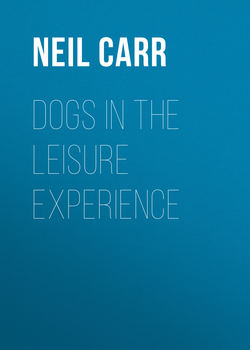Читать книгу Dogs in the Leisure Experience - Neil Carr - Страница 13
На сайте Литреса книга снята с продажи.
Cultural Constructions of ‘Dog’ and the Human Owner/Companion
ОглавлениеAs Bekoff (2007: 156) noted: ‘How animal images and live animals are represented in advertisements, on television, in movies, in cartoons, and in other forms of entertainment influence what people come to believe about them.’ In this way the media may be seen as the constructor of the sociocultural view of the ‘dog’. Yet this is an oversimplification of a more complex reality that is at the heart of the never-ending debate surrounding the relation between human agency and structure. The media as the representation of culture certainly builds a picture of what a dog is and how it relates to humans and should be treated, but the media is itself influenced by the images held by the individual. In effect it is a never-ending feedback loop with no beginning and no end. To try and find which originally caused the other is a fruitless endeavour when the reality is that they are both intimately related to one another. The situation is even more complicated when it is recognized that we are dealing with not just the view of humans but the dogs’ perspective as well. This leads to the question of whether the sentience of the dog is simply a product of human cultural constructs or a reality now being integrated into human culture. The answer is that one feeds off the other. Dog sentience is real but its specific nature is coloured in the eyes of humans by human culture, which in turn is influenced by the media.
There are instances where fictional dogs have morphed into physical tourist attractions, as shown in Fig. 1.2 where Gromit, of Wallace and Gromit fame, has become a larger-than-life and very colourful tourist attraction in parts of the UK; the representation in Fig. 1.2 was spotted outside the entrance to Bristol Zoo. Statues such as the Gromit one are popular tourist attractions because of how they depict the character seen on television and at the movies. They are a physical embodiment of the anthropomorphic fictional character and as such they help to reinforce the message that Gromit purveys: that dogs are sentient beings capable of multiple complex feelings and feats. In this way Gromit provides an excellent example of how society perceives and constructs the dog. Yet these perceptions and constructions can also be influenced by the reality of dogs and their own inherent characteristics. The list of other dogs who have been portrayed in human culture and in doing so helped to shape how we view dogs is without end. It includes, among others, my own favourite; Dog, a cartoon character created by Murray Ball and a wonderful representation of both the Collie and the quintessential New Zealand farm. A detailed examination of the role of dogs in fictional media is beyond the scope of the present work, but will be examined in a chapter of a book I am editing about domesticated animals (Carr, forthcoming a).
Fig. 1.2. Gromit at Bristol Zoo, UK (2013).
Just as the dog is a cultural construct in the eyes of humans, so is the dog owner or human companion. Society depicts acceptable images of dog owners and human companions, helping in the process to mould the behaviour of these people and how they wish to be perceived by society. At the same time, the behaviour of these people influences media representations of the ‘good’ dog owner. These images are depicted both in factual and fictional media: the latter including everything from Wallace (the ‘owner’ of Gromit) to Wal Footrot (the owner of Dog) and George (the Famous Five owner of Timmy).
